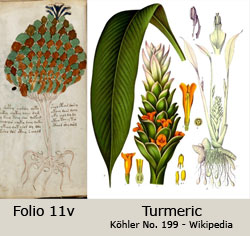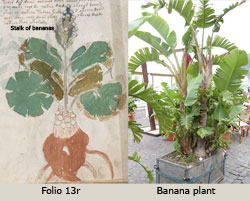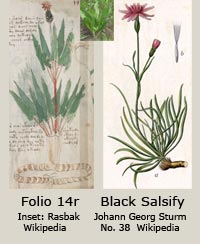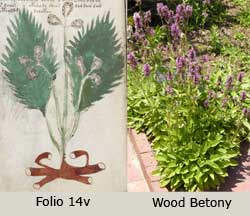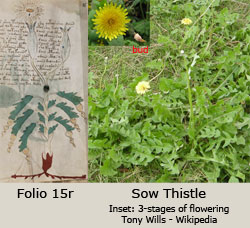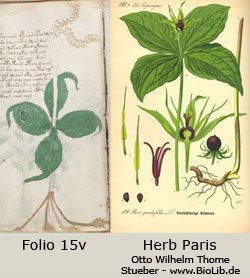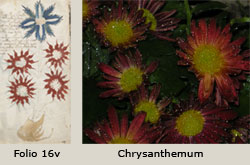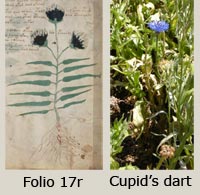The Voynich Botanical Plants
Folio 11v, Turmeric (Curcuma longa), is a rhizomatous, herbaceous, perennial plant of the ginger family, native to tropical South Asia. In medieval Europe, turmeric was known as Indian Saffron and was used as an alternative to saffron. Turmeric is the yellow spice used in Indian curries and found in American prepared mustard, and is produced by boiling, drying, and then grinding the rhizomes. People whose diets are rich in turmeric have lower rates of breast cancer as well as prostate, lung, and colon cancers.
Folio 13r, Banana, is indigenous to Southeast Asia. The main banana stem is known as a pseudo-stem and dies after it produces a stick of bananas and is replaced by another pseudo-stem. Folio 13r indicates that this plant had a number of pseudo-stems. Arab traders introduced bananas into West Africa and, in the early 15th century, Portuguese sailors, while exploring the African coastline, discovered the tropical fruit and started banana plantations in the Canary lslands (http://www.banana.com/).
Folio 13v, Honeysuckles or Woodbines (Lonicera periclymenum), are vines or shrubs native to the Northern Hemisphere. The plant has simple, opposite, oval leaves; and sweetly-scented, bell-shaped flowers. The smaller, Italian honeysuckle of Mid and Southern Europe is used as a skin tonic, and the seeds as a diuretic. Dioscorides (ca.40~90 AD) who wrote De Materia Medica, the precursor of the modern pharmacopeias, wrote that “a syrup made of the flowers is good to be drunk against diseases of the lungs and spleen.”
Folio 14r, Black Salsify or Viper’s grass (Scorzonera), is a native of Southern Europe, where it was cultivated as a root vegetable around 1500 AD. It has spear-shaped leaves, yellow ray flowers, and a thin black taproot that grows up to one meter long and up to 2 cm in diameter. The roots were foraged by the ancient Greeks and Romans. During the Middle Ages, the plant was used as a tonic and a cure for snakebites, hence the common name “viper’s grass.”
Folio 14v, Wood Betony, Heal-all, Self-heal, or Woundwort (Stachys monnieri), is a large, upright, perennial herb found in the grasslands of Europe, Western Asia, and North Africa. It is a creeping, self-rooting plant with large, lance-shaped, serrated leaves growing on short stalks in opposite pairs at the base of the upright stems. The flowers grow from a clublike, whirled cluster at the end of the stalk. Antonius Musa, chief physician to the Emperor Augustus, claimed that it cured 47 diseases and was effective against sorcery. It was planted in graveyards to prevent activity of ghosts.
Folio 15r, Sow Thistles (Sonchus oleraceus), are common roadside plants native to Eurasia. The ancient Greek name for these plants was Sonchus. It is taprooted, has irregularly lobed leaves that clasp the stem, and yellow flowers of the ray type. The stem contains a milky latex. The plants were fed to lactating sows in the belief that their milk production would increase.
Folio 15v, Herb Paris (Paris quadrifolia), occurs in cool areas throughout Europe and Asia. This unusual plant has fleshy roots, and a single upright stem, with four pointed leaves near its top. From the center of the leaves, a single, green-white flower arises with greenish, filiform petals and green, petaloid sepals. The black, berry fruit is poisonous. The plant is also known as “true love” and was once used as an aphrodisiac. The seeds and berries have narcotic properties.
Folio 16r, Cannabis, is indigenous to Central Asia around the Caspian Sea. It was introduced into Western Asia and Africa, and subsequently, Europe in 2,000–1,000 BC. Cultivation in Europe became widespread in about 500 AD. Cannabis is one of the worlds oldest crops and provides a number of useful products: fiber from the stems, therapeutic agents and narcotics from the flowers and leaves, and oil from the seeds (Prota Database). It is best known as the illegal drug marijuana.
Folio 16v, Chrysanthemum plants, are native to Asia and Northeastern Europe. The photograph shown in Figure 16v was taken in Italy and is probably of a cultivated plant. I am showing it because I was struck by how closely it resembles the red flowers in Folio 16v. I have no idea of the identity of the blue flower. Folio 16v could also be ‘red’ yarrow, as shown in this Wikipedia photo.
Folio 17r, Cupid’s dart (Catananche caerulea), is a member of the daisy family and native to the Mediterranean region. The plant grows in clumps. The stems are thin and wiry; the gray-green leaves are shaped like spears; and ray flowers are blue. The ancient Greeks and Romans used this plant as ingredient in a love potient, so it may have been the “date rape” drug of ancient times.
